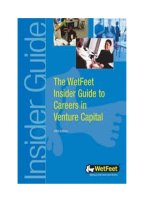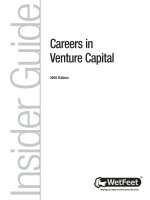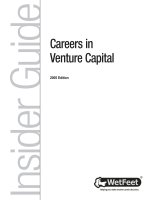Insider Guide Careers in Venture Capital PHẦN 8 ppsx
Bạn đang xem bản rút gọn của tài liệu. Xem và tải ngay bản đầy đủ của tài liệu tại đây (124.71 KB, 12 trang )
Lifestyle and Culture
The lifestyle of venture capitalists varies widely. The industry is filled with
workaholics who toil around the clock to stay ahead of fast-changing technology
industries. “Your calendar is a slight representation of what you end up doing.
My entire day is interrupt-driven,” says an insider. “My time is my most
valuable asset. You’ve got to switch contexts, issues, and frameworks all the
time. Some people like that; some people hate it.” Insiders say that once a
venture capitalist is established, the lifestyle can be better than in similar hard-
driving, high-paying industries.
The VC culture is much harder to peg. Since most VC firms are small, the
partners really set the tone, so culture at firms varies widely. Partners more
focused on doing deals will take a hard-line, almost I-banking, approach. Partners
who spend more time working with entrepreneurs might have a more informal
attitude. However, since there is so much competition—and since moving to
another firm isn’t the easiest thing to do—one associate says, “Get to know the
culture and make sure you fit. If people like you, you’ll do well.”
102
The Workplace
Hours
Hours are completely self-determined and are based on what you think you need
to do to bring in a good IRR on your investments. Some VCs work as much as
20 hours a day managing their portfolio companies and staying ahead of the
industry. Others lead a more sane life, fitting in lots of golf, tennis, and skiing.
In general, the junior members of the firm work more hours than the partners,
although there are plenty of workaholic partners. Industry insiders tell us that if
there were a “typical” workweek, it would be 10 to 12 hours per day on weekdays.
One partner calls time management the most challenging aspect of venture
capital, saying, “VCs are barraged with e-mail, voice mail, and business plans.
You can’t be completely reactive. You have to manage the flow of business
plans and requests.”
Another insider calls the hours manageable for anyone who can thrive in a
cyclical, multitasking work environment. “Unlike investment banking and
business consulting, where you’re more or less working on a single project but
the work is heavy, in a VC firm you’re working on several projects. With start-
up businesses, there are certain times when they need lots of attention and lots
of help, and other times where you don’t hear from them for a week or two.
The phone doesn’t turn off; your e-mail doesn’t turn off.”
On weekends, you are likely to work at home reading business plans and
industry publications. Sometimes you may need to spend a half-day of your
weekend traveling to or from an industry conference. However, in most cases,
your work life will leave some room for a personal life. You’ll just have to make
the latter fit around the former.
103
The Workplace
Workplace Diversity
VC is one of the WASP-iest of industries. Says one partner in Silicon Valley,
“There are not that many minorities. I don’t know a single black venture
capitalist.” Another insider agrees: “African Americans and Latinos are largely
absent.” In fact, the only minorities that seem to be even nominally represented
are Asians and Indians. One partner blames an educational system that fails to
give minorities the tools they need to make it into the MBA club in numbers
sufficient to have an impact on the rarefied VC industry: “We’re at the end of
the pipeline.”
Opportunities for Women
VC is a predominantly white, male industry, but women we’ve talked to who
work in VC haven’t reported feeling discrimination. “In general, I don’t feel like
it’s a disadvantage or an advantage to be a woman,” says one. Some female
venture capitalists, including Anne Winblad of Hummer Winblad, Mary Jane
Elmore of Institutional Venture Partners, and Nancy Shoendorf at Mohr
Davidow, are major players in the industry. However, a March 2004 report
released as part of the Diana Project, a multiyear, multiuniversity study of
women in business, suggests that opportunities for women are not equal to
those for men. According to the study, Gatekeepers of Venture Growth: The Role
and Participation of Women in the Venture Capital Industry, women comprised
about 10 percent of VCs from 1995 to 2000, despite a 62 percent growth in
the number of venture capitalists. During the period of the study, female
representation in management positions declined from 27 percent in 1995 to
25 percent in 2000, and women left the industry at roughly twice the rate that
men left the industry.
104
The Workplace
These numbers paint a disappointing picture. In 2002, women led 28 percent of
all U.S. businesses, employing more than 10 million people and with $1.5 trillion
in sales. Yet female entrepreneurs received a disproportionately low share of
venture capital—from 4 to 9 percent (partly due to the fact women are less likely
to seek venture financing than men; this begs the “chicken or egg” question).
Seventy percent of female VCs were in partnerships that closed deals with
women-led companies, indicating that firms with female VCs played a
disproportionate role in funding women-led firms. The study concluded that
more female VCs would increase networking opportunities between VCs and
female entrepreneurs, lead to more proposals being brought to the partnerships,
increase opportunities for women-led ventures to access capital and build wealth,
lessen the chances VCs would miss out on promising women-led ventures, and
give women a more powerful voice in the entrepreneurial progress of the country.
In this light, the failure of firms to employ women in higher percentages is a
missed opportunity for VC.
105
The Workplace
Travel
Travel is the one area where venture capitalists have a large advantage over
other hard-driving businesspeople such as management consultants. Many firms
restrict their investments to a regional area near their offices. Silicon Valley VC
firms, for instance, generally only invest in Silicon Valley or the Pacific Northwest.
Other regional firms, like the Texas Growth Fund, are chartered to invest in a
given region. East Coast VC firms tend to spread out investments more,
because the opportunities in their region are not so geographically concentrated.
When firms decide to invest in new locations, they often open new offices in
those areas, alleviating the need for partners to travel. Firms also often invest in
tandem with other firms; the firm closer to the portfolio company generally
takes a more hands-on approach so the other firm needn’t make the trek to the
company’s offices.
That said, partners often spend their days moving among their portfolio start-
ups in their given regional areas. One insider says that a typical day might
involve six meetings in different locations. Although you won’t spend 4 days
each week living out of a suitcase, you may spend 4 hours a day in your car.
106
The Workplace
Compensation
The salary range for analysts varies from $55,000 to $150,000 per year including
bonuses, averaging north of $100,000 in a good year. Associates are likely to
make from $75,000 to $250,000, including bonuses, averaging $180,000 in a
good year. A junior partner averages around $300,000 a year. Good money, but
poverty wages compared to what partners can make.
Compensation for partners is fairly standardized in the venture capital industry.
Partners split an annual management fee paid by limited partners equal to 2 to
3 percent of the assets of the fund. They also split 20 to 25 percent of the
returns on their investments. (The limited partners or investors get the rest.)
Let’s work out some of these figures to see how much a venture capitalist can
make. Take a firm that has six partners and $200 million under management.
The 2.5 percent management fee amounts to $5 million. Let’s say expenses of
$1 million are paid out of that $5 million, leaving $4 million to be split among
the six partners. That works out to $667,000 in annual salary per partner,
regardless of how their investments perform.
Venture capitalists make their really big money in the profit-taking from
successfully performing funds. This compensation is cyclical and not spread
evenly from one firm to another, but let’s take a look at what an accomplished
partner can make in carry. Again, assume our firm has six partners and
$200 million under management. A successful fund might return three times
the investment, so let’s say that our fund nets $400 million. Our firm takes
25 percent of $400 million, or $100 million, and returns the other $300 million
to the investors. Let’s assume that the $100 million is paid out over 6 years, an
107
The Workplace
average fund length, so profits work out to $16.7 million per year. Finally, we
need to divide up the carry among our six partners, so they each get $2.8 million
annually. That’s a nice chunk of change.
Of course, a firm’s profits can swing wildly depending on how well the investments
do. “In pre-Internet days, three to five times was a good return [on a fund],”
one insider says. “In the Internet time, it was sometimes 20 to 30 times.” As a
general rule today, VCs are looking at a return ranging from three to ten times
the original investment.
108
The Workplace
Career Notes
Undergraduates
Working at a venture capital firm as an analyst can be a great way to get a
toehold in the industry. You will get to learn from extremely smart, experienced
business people in a smaller, more humane work environment than you would
on Wall Street. Insiders tell us that you shouldn’t expect to stay more than a
couple of years, but it’s a good way to learn about entrepreneurship from the
financing side before you go back to business school or into industry.
MBAs
Venture capital has become a much-sought-after career for MBAs, especially
those who already have industry experience. The intellectual challenges, the
mixture of financial and strategic skills practiced, and potential financial rewards
have made this a top job choice for the few who are lucky enough to get in.
Having an MBA is a must to get a partnership in venture capital, unless you have
a proven business track record in a specific industry. Insiders tell us that you can
expect to make partner in 3 to 5 years. If you don’t, you’ll have to either take
another associate position at another firm or move on to a different career.
109
The Workplace
Insider Scoop
What Employees Really Like
Intellectual Stimulation
Industry insiders tell us that they love working with some of the smartest
people in the world. Not only are your colleagues going to be the best and the
brightest, but so are some of the entrepreneurs. “It’s capitalism at its purest,”
says one insider. “I run around finding great people to hitch my wagon to. I’m
not making a widget or writing software. I work with people so passionate
about a vision that they’re not going to put up with failure.” Another says,
“You’re exposed to a greater range of ideas. There’s never a dull moment.”
Focus on the Bottom Line
Venture capitalists, unlike management consultants, have a financial stake in the
success of the companies with which they work. There are no gray areas in
determining the IRR of your investments, so there’s less room for politicking
and favoritism. As one insider says, “It’s an individual effort in a team context.
VC firms tend to be small and have tangible goals. There’s a lower degree of
politics: They tend to be meritocracies.” At the same time, though it may be
hard to get a venture capitalist to admit it, there seems to be a good deal of
satisfaction that comes from telling entrepreneurs how to run their businesses.
Cutting-Edge Exposure
In venture capital, you see the formation of cutting-edge businesses and
technologies on a daily basis. And if you’re lucky or good at what you do, you get to
play a role in making them successful. “The best part of the job is working with the
companies that we have funded,” an insider says. “I am always learning new things.”
110
The Workplace
Helping Build Firms
The greatest feeling for a venture capitalist is to see a firm
that he or she has backed for years complete a successful
IPO or grow into a thriving company. Not only does this
confirm that you backed the right horse;it is also exciting
to be around a start-up when it takes off. One insider
speaks for many when he says, “I get to observe and
participate in the growth of start-ups, the excitement of
watching one get its first customer, make its first million,
have a successful IPO. All along, I can make a meaningful impact.”
Bird’s-Eye View
Since you don’t have to deal with the operational details of running a business
and since you are constantly evaluating new business proposals in a given industry,
you really get a broad view of how an industry is changing and developing. As
one insider says, “You come out of business school thinking that running a
business will be your main function in the business world. In venture capital,
that’s not the case.”
Money
Though the income can be more deferred than in other industries, it’s pretty
darned good. One insider says dryly, “It might take a few years before a venture
capitalist gets wealthy.” Successful venture capitalists can make huge amounts of
money with less risk, and less chance of burnout, than entrepreneurs can.
Smart People
You work with smart, successful, driven people. “The people at the firm have
great experience, are incredibly smart, and have great insights, or they wouldn’t
be here,” says an insider. “Across the board you’re dealing with really intelligent,
high-caliber people.”
111
The Workplace
VC firms tend to
be small and have
tangible goals.
There’s a lower
degree of politics:
They tend to be
meritocracies.
“ ”
Watch Out!
Not Melrose Place
As one partner put it to a group of starry-eyed MBAs, “Many of you will choose
not to believe me, but I assure you that VC is not a glamorous industry. We
watch our own costs closely; unlike investment banks or consulting firms, we
have no clients to whom we can pass on travel and entertainment costs. So if
creature comforts are what you crave as a sign of success, there are alternatives,
but VC is not one of them.”
No Vacancy
It’s really hard to break into the VC industry. Although MBAs can and do find
homes in venture capital, and although there are more openings than ever, many
people spend a lot of time chasing jobs that never materialize. If you don’t have
some stellar credentials to begin with, you might be better off pursuing other
career opportunities.
Concrete Ceiling
Venture capitalists are measured by the return on the investments they back and
may find themselves out of work if they don’t produce in the early years.
“If you don’t have the returns, you’ll totally disappear,” one insider bluntly
says. Furthermore, the skills picked up in VC are not easily transferred to other
industries. “It’s difficult to go on and take an operational role [after leaving VC].
There’s a fork in the road, and you have to be confident that you want to take
[the VC] path,” says one insider.
Necessary Evils
It’s hard to find a venture capitalist who doesn’t firmly believe that he has
“added loads of value” to entrepreneurial start-ups and to the world at large.
But it’s relatively hard to find a true entrepreneur who doesn’t look at venture
112
The Workplace
capital with some significant reservation, if not worse. Starting and funding
companies is a high-stakes business. Venture capitalists are often criticized for
pushing companies too hard to grow too fast and go public at the earliest
possible date. It’s not uncommon for them to step on toes and use their
ownership stake to force a company to make controversial moves.
In a Lonely Place
Many insiders report that this can be a lonely business, not unlike sales, where it
is up to you to discover and nurture new investments—sometimes in competition
with your partners. One insider says that, even at portfolio companies where
you’ll expend a good amount of your energies, “you won’t directly witness
success. You’re in a sense, an outsider.” One insider says that he and his partners
are all individual practitioners: “You take care of your own board seats, and you
don’t get pats on the back. It’s like we’re all coaches on staff at Stanford. But
we each coach a different sport—one coaches swimming, one tennis, one
basketball, and so on.”
It’s a Man’s, Man’s, Man’s World
A haven of diversity VC is not. Although some firms do have women partners,
venture capital has traditionally been a club for white males. As one insider says,
“There are a lot more women in VC than people might expect. But lots of
them are associates. It’s not going to change too quickly.”
Not Every Idea Flies
VCs have a real financial stake in their business. And among the many start-up
successes, there are always going to be failures. “People are less aware of it in
the good times,” says one insider, “but losses are a reality of this business. There
are painful stories of layoffs and dreams that didn’t work out. They’re the ones
that keep you up at night.”
113
The Workplace









